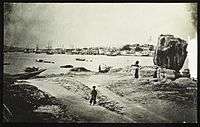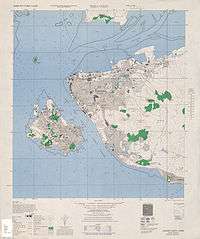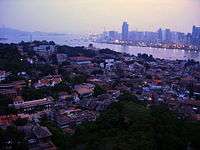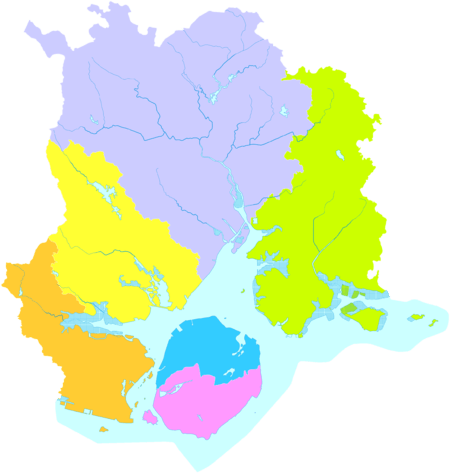Xiamen
Xiamen, formerly romanized as Amoy, is a sub-provincial city in southeastern Fujian, China, beside the Taiwan Strait. It is divided into six districts: Huli, Siming, Jimei, Tong'an, Haicang, and Xiang'an. Altogether, these cover an area of 1,699.39 square kilometers (656.14 sq mi) with a population of 3,531,347 as of 2010. The urbanized area of the city has spread from its original island to include parts of all six of its districts, with a total population of 1,861,289. This area connects to Quanzhou in the north and Zhangzhou in the west, making up a metropolis of more than five million people. The Jinmen or Kinmen Islands administered by the Republic of China lie less than 6 kilometers (4 mi) away.
Xiamen Island was considered to possess one of the world's great natural harbors in Yundang Bay, but Fujian's international trade was long restricted to Quanzhou or to Guangzhou in Guangdong. Due to the siltification of Quanzhou's harbor, the British insisted that Xiamen be opened to foreign trade in the treaty that ended the First Opium War in 1842. Under the Qing, both before and after the war, there was large-scale emigration of Chinese from southern Fujian spread Hokkien-speaking communities to Singapore, Malaysia, and Indonesia. The overseas Chinese continue to support Xiamen's educational and cultural institutions. As part of China's Opening Up Policy under Deng Xiaoping, Xiamen became one of the original four special economic zones opened to foreign investment and trade in the early 1980s. Its former harbor was enclosed using land excavated during the city's expansion.
The city is known for its mild climate, Hoklo influence and colonial architecture, as well as its relatively low pollution. In 2006, Xiamen was ranked as China's 2nd-"most suitable city for living", as well as China's "most romantic leisure city" in 2011.
Name
The area around Xiamen Bay appears as Tong'an in some Han records. Xiamen Island was described as Jiahe Islet c. 976. It received its present name from the Xiamen Castle erected on the island by Zhou Dexing in 1387 during the Ming.[4] The name was formerly written using the Chinese characters meaning "Lower Gate". When its port prospered under the Qing, the name was considered unrefined and changed to homophonous characters meaning "Mansion Gate". Xiamen is the atonal pinyin romanization of the characters' pronunciation in Mandarin. It has also been romanized as Hiamen.[5] The former English name "Amoy" was based on the same name's pronunciation in the local dialect of Hokkien, Ē-mûi.
Xiamen was also named Siming ("Remembering the Ming") for a few years (1656–c. 1661) during its occupation by the loyalist Southern Ming forces of Koxinga. The Qing restored the former name upon their conquest of the area, but Koxinga's name was in turn restored after the Xinhai Revolution that inaugurated the republic in 1912. The name Xiamen was later restored again but Siming continues to be used as the name of one of its districts.
Geography
Xiamen is a sub-provincial city in southeastern Fujian whose urban core grew up from the port of Xiamen on southern Xiamen Island, now located within Siming District. It now also includes Gulangyu Island and the rugged coast of the mainland from the northeast bank of the Jiulong River in the west to the islands of Xiang'an in the east. Xiamen Island lies about one degree north of the Tropic of Cancer.[6] It is divided between Huli District in the north and Siming District in the south. Siming also includes Gulangyu. Its mainland territory is divided among Haicang, Jimei, Tong'an, and Xiang'an districts.
In the 19th century, Xiamen's harbor on Yundang Bay was considered one of the world's great natural harbors. Land reclamation has since been used to fill in the mouth of this inlet, turning it into Siming District's Yundang Lake. The municipal government is located on other reclaimed land beside it.
The nearest point of Lieyu in the Jinmen Islands, still controlled by the Republic of China from Taiwan, lies only 6 kilometers (4 mi) off Xiamen Island.[7]
Climate
Xiamen has a monsoonal humid subtropical climate (Köppen Cfa), characterised by long, hot and humid summers (but moderate compared to much of the rest of the province) and short, mild and dry winters. The warmest month is July, with a 24-hour average of 27.8 °C (82.0 °F), and oddly, the coolest month is February, averaging 12.4 °C (54.3 °F); the annual mean is 20.42 °C (68.8 °F). Extremes since 1951 have ranged from 1.5 °C (35 °F) on 29 December 1991 to 39.2 °C (103 °F) on 20 July 2007.[9] Spring, both by humidity and percentage of sunshine, is the dampest season but typhoons in late summer and early autumn can make the latter period wetter overall. Summer and autumn are marked by comparatively sunny conditions, while autumn is warm and dry. The annual rainfall is 1,350 millimeters (53 in). With monthly percent possible sunshine ranging from 24% in March to 56% in July, the city receives 1,853 hours of bright sunshine annually. Frost occurs very rarely, and the last snowfall in the city took place in January 1893, when snow also fell at Guangzhou, Macau, in the inland parts of Hong Kong and in the hills of Taipei.
The area is known within China for its relatively low pollution.[10]
| Climate data for Xiamen (1971–2000) | |||||||||||||
|---|---|---|---|---|---|---|---|---|---|---|---|---|---|
| Month | Jan | Feb | Mar | Apr | May | Jun | Jul | Aug | Sep | Oct | Nov | Dec | Year |
| Average high °C | 17.0 | 16.6 | 18.8 | 23.1 | 26.6 | 29.5 | 32.0 | 31.8 | 30.0 | 27.4 | 23.6 | 19.2 | 24.6 |
| Average low °C | 9.7 | 9.8 | 11.8 | 15.9 | 19.9 | 23.3 | 25.0 | 24.8 | 23.3 | 20.3 | 16.2 | 11.7 | 17.6 |
| Average rainfall mm | 34.2 | 99.4 | 125.2 | 157.0 | 161.8 | 187.2 | 138.4 | 209.0 | 141.4 | 36.2 | 31.1 | 28.2 | 1,349.1 |
| Average high °F | 62.6 | 61.9 | 65.8 | 73.6 | 79.9 | 85.1 | 89.6 | 89.2 | 86 | 81.3 | 74.5 | 66.6 | 76.3 |
| Average low °F | 49.5 | 49.6 | 53.2 | 60.6 | 67.8 | 73.9 | 77 | 76.6 | 73.9 | 68.5 | 61.2 | 53.1 | 63.7 |
| Average rainfall inches | 1.346 | 3.913 | 4.929 | 6.181 | 6.37 | 7.37 | 5.449 | 8.228 | 5.567 | 1.425 | 1.224 | 1.11 | 53.112 |
| Average rainy days (≥ 0.1 mm) | 7.1 | 12.0 | 15.4 | 14.6 | 15.2 | 14.8 | 9.9 | 10.9 | 9.0 | 3.2 | 4.0 | 4.9 | 121.0 |
| Average relative humidity (%) | 75 | 80 | 83 | 82 | 84 | 86 | 82 | 82 | 78 | 71 | 70 | 70 | 78.6 |
| Mean monthly sunshine hours | 133.3 | 88.3 | 89.6 | 105.6 | 132.6 | 163.8 | 234.6 | 211.6 | 178.9 | 188.4 | 163.0 | 163.5 | 1,853.2 |
| Percent possible sunshine | 40 | 28 | 24 | 28 | 32 | 40 | 56 | 53 | 49 | 52 | 50 | 50 | 41.8 |
| Source: China Meteorological Administration[8] | |||||||||||||
History
The area of Xiamen was largely bypassed by the Qin and Han conquests and colonization of Guangdong, which passed west of Fujian down the Lingqu Canal between the Xiang and Li rivers. It was first organized as Tong'an County in AD 282 under the Jin, but it lost this status soon afterwards. Tong'an County was again established in 933 under the Later Tang.
The settlement on the southeastern shore of Xiamen Island[12] (now part of Siming District) developed as a seaport under the Song, although legal foreign trade was restricted to nearby Quanzhou, which administered the area. In 1387, attacks by the "Japanese" or "dwarf" pirates—many of them actually disaffected Chinese—prompted the Ming to protect the harbor with the fortress that gave Xiamen its name. The Portuguese first reached Xiamen in 1541. After the fall of the Ming to the Qing in 1644, Southern Ming loyalists including Koxinga used Xiamen as a base from which to launch attacks against the invading Manchus from 1650 to 1660.[13] In 1661, Koxinga drove the Dutch from Taiwan and moved his operations there. His base on Xiamen fell to a combined Qing and Dutch invasion in 1663.[14] The East India Company traded extensively with the port, constructing a factory there in 1678.[14][lower-alpha 1] It was raised to the status of a subprefecture in 1680, but the taxes and other restrictions placed on traders compelled the British to relocate to Canton and Fuzhou the next year.[14] Trade resumed in 1685[15] and continued until the imposition of the Canton System.
By the 19th century, the city walls had a circumference of around 9 miles (14 km), with an inner and outer city divided by an inner wall and a ridge of hills surmounted by a well-built fort.[12] The inner harbor on Yundang Bay was also well fortified[12] and these defenses were further strengthened upon the outbreak of the First Opium War.[15] Nonetheless, Xiamen was captured in 1841 between Guangzhou and Zhoushan. Rear Adm. Parker bombarded the Qing position to little effect, but the assault by the men under Lt. Gen. Gough caused the Chinese to flee their positions without a fight.[15][16] The city was abandoned during the night[11] and fell the next day on 27 August.[17] The Chinese had spirited out the entire treasury of sycee bullion under the nose of the British by disguising it inside hollow logs.[11] Xiamen being too large to garrison, a small force was left to hold Gulangyu.[18] The next year, the Treaty of Nanjing made Xiamen one of the first five ports opened to British trade, which had previously been legally restricted to Guangzhou. Subsequent treaties opened the port to other international powers.
As the primary international port for Fujian, particularly Zhangzhou and its hinterland,[12] Xiamen became a center of China's tea trade, with hundreds of thousands of tons shipped yearly to Europe and the Americas.[19] Its local dialect influenced a variety of translations of Chinese terms. Its principal exports during the period were tea, porcelain, and paper;[lower-alpha 2] it imported sugar, rice, cotton, and opium, as well as some manufactured goods.[12][lower-alpha 3] Xiamen was also a center of Protestant missionaries in China;[20][21] the missions operated the city's two hospitals.[22] The merchants of Xiamen were thought among the richest and most entrepreneurial[12] and industrious[23] in China, but the city was widely accounted the dirtiest city in China.[12][5][22] Owing to local belief in feng shui, the streets were "as crooked as ram's horns"[22] and averaged about 4 feet (1 m) in width to keep out sunlight and control public disturbances.[24] Its population was estimated at 250,000 in the 1870s;[12][lower-alpha 4] by that point the island was largely barren and full of roughly 140 villages, with a total population around 400,000.[25] European settlement in the port was concentrated on Gulangyu Island off Xiamen proper; it remains known for its colonial architecture.
-

An 1869 stereogram of laborers in Xiamen. The first coolies left Xiamen for Havana in 1847
-

"Plan of the Country around Amoy", 1870[2]
-

A stereogram of houses in Xiamen c. 1870
-
%2C_Fukien_province_Wellcome_L0055717.jpg)
Nanputuo Temple c. 1870[3]
- ^ Wright, G.N. (1843), [www.archive.org/stream/chinainseriesofv02wrig#page/n5/mode/2up China, in a Series of Views, Displaying the Scenery, Architecture, and Social Habits of That Ancient Empire, Vol. II] Check
|url=value (help), Fisher, Son, & Co., p. 69, illustrated by Thomas Allom. - ^ Morrison, George Ernest (c. 1870), Album of Hongkong, Canton, Macao, Amoy, Foochow, p. 50.
- ^ Thomson, John (1898), Through China with a Camera, Westminster: A. Constable & Co., p. 96.
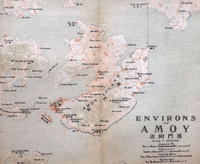
By the 20th century, the local export economy had collapsed due to the success of British tea plantations in India.[5] During the Qing and the early 20th century, many southern Fujianese emigrated to Southeast Asia and Taiwan, spreading Hokkien language and culture overseas. Some 350,000 overseas Chinese currently trace their ancestry to Xiamen.[27] Some of this diaspora later returned: an estimated 220,000 Xiamen residents are returning overseas Chinese and their kin.[27] Others continue to help fund universities and cultural institutions in Xiamen.
At the time of the Xinhai Revolution, the native population of the city was estimated at 300,000 and the foreign settlement at 280.[5] After the establishment of the Republic of China, the area around Xiamen was renamed Siming County. Xiamen's trade during the period was largely conducted through Taiwan,[5] which had been seized by Japan during the First Sino-Japanese War. The Japanese subsequently claimed Fujian as their sphere of influence during the colonial squabbling over China.[5] Japan occupied Xiamen Island from May 1938 to September 1945 during World War II. In the late phases of the Chinese Civil War that followed, the Communists captured Xiamen and Gulangyu in October 1949 but failed to capture Jinmen. The same year, Xiamen became a provincially-administered city (省辖市).
In 1955 and 1958, mainland China escalated Cold War political tensions by shelling nearby islands from Xiamen in what became known as the First and Second Taiwan Strait Crisis. The Nationalists responded by reïnforcing Jinmen and shelling Xiamen. The Gaoji Causeway built from 1955–57 notionally transformed Xiamen Island into a peninsula, and so it was termed in the heady propaganda of the time. Due to political tensions, the eastern half of Xiamen Island and much of the Fujian Coast facing the offshore islands remained undeveloped in the 1960s and 1970s. The Water Police and Post-Office were situated directly across the water from the American embassy.

When Deng Xiaoping initiated his Opening Up Policy, Xiamen was made one of the first four special economic zones in 1980, with special investment and trade regulations attracting foreign investment, particularly from overseas Chinese.[28] The city grew and prospered. On April 18, 1988, Xiamen was promoted to sub-provincial status and began to be specially considered in China's state planning. In 2001, the governments of mainland China and Taiwan agreed to initiate the "Three Mini-Links" and restored ferry, commercial, and mail links between the mainland and offshore islands. Trade and travel between Xiamen and Jinmen was restored and later expanded to include direct air travel to Taiwan Island. In 2010, travelers between Xiamen and Jinmen made 1.31 million trips.[29]
In 1999, the largest corruption scandal in China's history was uncovered in Xiamen, implicating up to 200 government officials. Lai Changxing is alleged to have run an enormous smuggling operation, which financed the city's football team, film studios, largest construction project, and a vast brothel rented to him by the local Public Security Bureau. According to Time, "locals used to joke that Xiamen should change its name to Yuanhua, the name of Lai's company." They subsequently claimed that potential investors were discouraged by the taint of corruption.[30]
In 2006, Xiamen was ranked as China's 2nd-"most suitable city for living",[31] as well as China's "most romantic leisure city" in 2011.[32]
Demographics
According to the 2010 Census, Xiamen has a population of 3,531,347 inhabitants, almost 1.8 times the population counted for the last census in 2000 (which was of 2,053,070 inhabitants). The annual average population growth was of 5.57% for the period 2000–2010.,[33] however this masks the population explosion in Jimei District, which quadrupled since the prior census; Huli District's population more than doubled,[34] The resident population was 1,967,800 in 2013 yearend, and with a population of 3.73 million (those residing at least half a year).[35] The total resident population is said to be 4,255,000 in December 2014, without specifying what counts as a resident.[36]
Languages
The local vernacular is Amoy, a dialect of Southern Min, also called Hokkien. Amoy is widely used and understood across the southern region of Fujian province as well as overseas. While it is widely spoken in and around Xiamen, the Amoy dialect has no official status, and the official language of all government business is Mandarin. The English words "Amoy", "tea" (茶; tê), "cumshaw" (感謝; kám-siā), and "Pekoe" (白毫; pe̍h-hô), kowtow (磕頭; khàu-thâu), and possibly Japan (Ji̍t-pún) and "ketchup" (茄汁; kiô-chap) originated from Amoy.
Religion
In the 19th century, Xiamen proper had two Dutch Reformed[lower-alpha 5] and two LMS churches.[20] Xiamen Island was home to three Dutch Reformed missions at "Kang-thau", "Kio-than", and "Chhan-chhu-oa".[25]
Administration
Xiamen is a sub-provincial city[37] of Fujian with direct jurisdiction over 6 districts.
| Map | Name | Simplified Chinese | Pinyin | Population (2010 census) |
Area (km2) |
Density (/km2) | |||||
|---|---|---|---|---|---|---|---|---|---|---|---|
| Huli District | 湖里区 | Húlǐ Qū | 931,291 | 73.77 | 14,782 | ||||||
| Siming District | 思明区 | Sīmíng Qū | 929,998 | 83.99 | 12,740 | ||||||
| Haicang District | 海沧区 | Hǎicāng Qū | 288,739 | 186.46 | 1,863 | ||||||
| Jimei District | 集美区 | Jíměi Qū | 580,857 | 274.29 | 2,105 | ||||||
| Tong'an District | 同安区 | Tóng'ān Qū | 496,129 | 669.36 | 754 | ||||||
| Xiang'an District | 翔安区 | Xiáng'ān Qū | 304,333 | 411.50 | 865 | ||||||
In May 2003, Gulangyu and Kaiyuan districts were merged into Siming District; Xinglin District (杏林区) was merged into Jimei District; and Xiang'an District was created out of a section of Tong'an District.
Economy


Xiamen has a diverse and well-developed economy. The Siming and Huli districts form its Special Economic Zone. Important industries are fishing, shipbuilding, food processing, tanning, textiles, machine tool manufacturing, chemical industries, telecommunications and financial services. The city has economic and trade relations with 162 countries and regions worldwide, and benefits from foreign investment, particularly capital from Hong Kong, Macau and Taiwan.
In 2008, a total of 356 projects with foreign direct investment had been approved in the city, with a contractual foreign investment amount of US$1.896 billion and an actual foreign investment amount of US$2.042 billion.[38] In 1992, Xiamen was ranked among the top 10 Chinese cities in relation to comprehensive strengths with its GDP increasing by an average of over 20% annually. In 2008, Xiamen's GDP amounted to 156 billion Yuan, an increase of 11.1% over the previous year; and the per-capita GDP was 62,651 yuan (US$9,017). Further economic reforms were introduced, and this brought the total volume of imports and exports in 2008 to US$45.4 billion, while that of exports totalled US$29.4 billion.[38]
Xiamen is also the host of the China International Fair for Investment and Trade held annually in early September to attract foreign direct investment into the Chinese mainland.
Xiamen has excellent road, rail, air and port infrastructure. In the last few years, Xiamen has invested more than RMB30 billion in infrastructure construction.
Financial services
Xiamen has highly developed banking services. The biggest bank is the state-owned commercial bank, Sino-foreign joint venture Xiamen International Bank, and solely foreign-funded Xiamen Bank.
Various foreign banks that have established representative offices in Xiamen.
There are more than 600 financial institutions in operation in Xiamen.
Industrial Zones
The Xiamen Export Processing Zone is located in the south part of Haicang Development Zone only 1.5 kilometers (1 mi) from the Haicang Port Area, 10 kilometers (6 mi) from Gaoqi International Airport and 3 kilometers (2 mi) from Haicang railway station. It has a favorable geographical location and well-developed transportation network, especially sea transportation. It has a total planned area of 2.4 square kilometers (1 sq mi) with 1.46 square kilometers (0.56 sq mi) for the first phase. Industries encouraged in the zone include Biotechnology/Pharmaceuticals, Chemicals Production and Processing, Heavy Industry, Instruments & Industrial Equipment Production, Medical Equipment and Supplies, Research and Development, Shipping/Warehousing/Logistics, Telecommunications Equipment, Trading and Distribution.[39]
Xiamen Haicang Taiwanese Investment Zone is situated to the southeast of Xiamen Island, at the tip of the Xiamen-Zhangzhou-Quanzhou Delta in South Fujian bordering Zhangzhou City to the west, Jimei District to the north, and overlooking Xiamen Island across the narrow water. The 100-square-kilometer Haicang Taiwanese Investment Zone is the largest national Taiwanese investment zone authorized by the State Council in 1989. It is situated close to Xiamen Port.[40]
Xinglin Taiwan Merchants Development Zone was approved to be established on 20 May 1989 by the State Council. The planned area is 19.36 square kilometers (7.47 sq mi) and the current area is 12.5 square kilometers (5 sq mi). The zone is located in Jimei, Xiamen. The main industries set up in the zone are chemistry, machinery, textile and electronics. The zone is 8 kilometers (5 mi) from the Xiamen Gaoqi International Airport and 3 kilometers (2 mi) from the 319 National Highway.[41]
Torch Hi-tech Industrial Development Zone was approved by the State Council as one of China's national level high-tech industrial development zones in March 1999. In 2001, the zone became the first to achieve 10 billion yuan per square kilometer target output level. It is located close to Xiamen Gaoqi International Airport.[42]
In 1992, Xiamen Xiangyu Free Trade Zone is established and approved by The State Council. The overall planning area is 0.63 square kilometers (0.24 sq mi). In 2008, there are 1100 enterprises in this park. Industries encouraged in the zone include Electronics Assembly & Manufacturing, Garment and Textiles Production, Trading and Distribution, Research and Development, Shipping/Warehousing/Logistics.[43]
Transportation
Local transportation

The Gaoji Causeway, four main road bridges (the Jimei, Xiamen, Xinglin, and Haicang Bridges), and the Xiangan undersea tunnel link Xiamen Island with the mainland.
The main forms of public transportation in Xiamen are bus and bus rapid transit (BRT). Xiamen's BRT system features a dedicated bus-only closed road system with stations and ticketing system similar to light rail. Most of the 115-kilometer (71 mi) BRT network consist of bus lanes along expressways and elevated BRT viaducts on Xiamen Island. BRT routes have no traffic lights and travel speed is limited by design to 60 kilometers per hour (37 mph). Five BRT routes are currently in service: BRT-1 Route, BRT-2 Route, Huandao Avenue BRT Route, Chenggong Avenue BRT Route and Connecting BRT Route. The fare is 0.6 RMB per km for the air-conditioned busses. The BRT is supplemented by 20 shuttle bus services that connect nearby places to the BRT stations. The shuttle bus service has a flat rate of 0.5 RMB. Fare discount is available when pre-paid e-card is used.
Taxis can be easily hailed in most areas of the city. Bicycles are commonly used by residents, especially on Xiamen Island. Unlike many Chinese cities, motorcycles, mopeds, tricycles, and wooden handcarts are not permitted in Xiamen. The city has upheld the ban on these vehicles since the 1990s. Electric bikes are permitted with proper licensing and obedience of traffic laws.[44] On the small island of Gulangyu off Xiamen Island, automobiles are also banned.
Xiamen Metro has been under construction since 2013 and the first line is scheduled to start operation in 2017. A system of three lines has been approved so far, with plans to eventually expand to six lines including service to surrounding suburban areas.
Road
The Fuzhou-Xiamen and Zhangzhou-Xiamen Express Highways link Xiamen with the highway network of Fujian and the neighboring provinces of Guangdong, Jiangxi and Zhejiang. There are also container freight services available between Xiamen and Shenzhen and Hong Kong.[45]
Railways
Xiamen is served by the Yingtan-Xiamen Railway, Longyan-Xiamen Railway and the Fuzhou-Xiamen High-Speed Railway, which are connected to China's national railway network. Direct passenger trains are available from Xiamen to Shanghai, Nanjing, Hefei, Fuzhou, Nanchang and Yingtan. The completion of the Xiamen-Shenzhen High-Speed Railway in late 2013 expanded train services to destinations to the west and southwest.
The Xiamen Railway Station on the island of Xiamen is connected to the mainland by a railway bridge.
The Xiamen North Railway Station is located in Jimei District.
The Xiamen East Railway Station will be located in Xiang'an District.[46]
Air
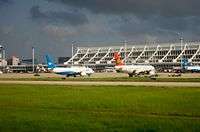
The Xiamen Gaoqi International Airport in northeastern Xiamen Island is a main air hub in East China with flights to over 90 domestic and international destinations. Among airports in China, Xiamen ranked among the top 11 for passenger traffic, top 8 for cargo traffic and top 10 for air traffic. It can handle 27 million passengers annually. The airport is the headquarters hub of Xiamen Airlines.
Xiamen has direct flights to most cities in China, Hong Kong, Macao, Taiwan, and major cities in east Asia like Tokyo, Osaka, Seoul. Intercontinental flights to Amsterdam, Sydney, Melbourne, Seattle have been started from 2011. Xiamen also hold a strong network to southeast Asia cities like, Bangkok, Kuala Lumpur, Manila, Jakarta, Cebu and Singapore, to server the large communities of southern Fujian's overseas diaspora and the increasing tourism flows.
Sea
Ferries
Xiamen has passenger ferry service to cities along the coast of China as well as the neighbouring island of Kinmen (Jinmen) to the east, which is administered by the Republic of China on Taiwan. These ferries are all served from the Wutong Ferry Terminal to Shuitou Pier, Kinmen on the north-east side of the Xiamen Island (quite distant from downtown Xiamen), ferries to Jinmen take 60 minutes. There are facilities in both directions allowing for quick transfers between Xiamen Gaoqi Airport (for Mainland destinations) and Kinmen Airport (for Taiwanese destinations), which is very popular with large tour groups.
The Heping Wharf Ferry Terminal on the south-west side of Xiamen Island offers short 5 minute boat rides to the island of Gulangyu however this is only accessible by Xiamen residents. Tourists and non-locals must now take a longer 20 minute ferry ride from the main International Ferry Terminal, also called the Dongdu International Terminal, on the south-west side of Xiamen Island., as of October 20, 2014 with a fare increase from 8RMB to 35RMB. This has been in order to reduce tourist numbers accessing the island in an effort to conserve it. This terminal used to have ferries, taking 90 minutes, to Kinmen Island but were ceased in 2014.
Port
The historic port of Xiamen in Yundang Bay on the southwest side of Xiamen Island has been converted into a lake by land reclamation projects.
The present-day Port of Xiamen lies on the northwestern shore of Xiamen Island, opposite its airport, and at eleven other sites around Xiamen Bay and along the Jiulong estuary, including the neighboring jurisdiction of Zhangzhou. The port facilities are interconnected by ship, road, and rail. The port has been one of the busiest in China since the early 1980s[46] and is serviced by all of the 20 largest shipping lines in the world. In 2013, Xiamen ranked among the top 20 ports in the world for container freight.
The natural coastline in the port area is 64.5 kilometers (40 mi) while the water is over 12 meters (39 ft) in depth. There are 81 berths, including 16 deep-water berths, of which 6 operate containers of over 10,000 tonnes. Among other cargoes handled, Xiamen is the world's largest supply base for raw tungsten materials[45] and sunglasses, exporting 120 million pairs each year.[45]
Xiamen is also an important base in Fujian province for making medium-sized and large modern container vessels and yachts[45]
Tourism


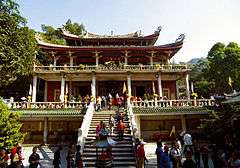
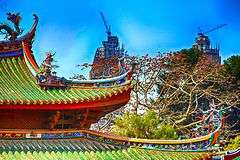
Xiamen and its surrounding countryside is known for its scenery and tree-lined beaches. Gulangyu, a former colonial enclave, is a popular weekend getaway with views of the city and features many Victorian-style buildings. Xiamen's Botanical Garden is a nature lover's paradise. The Buddhist Nanputuo Temple, dating back to the Tang Dynasty, is a national treasure. Xiamen is also well known as a continuing frontline in the Chinese Civil War, with the nearby Jinmen Islands remaining under Taiwanese control. Water Garden Expo Park has a total area of about 6.76 km2 (2.61 sq mi), with a land area of 3.03 km2 (1.17 sq mi) consisting of five exhibition park islands, four ecological landscapes islands and two peninsulas, including the main pavilion, Chinese Education Park, Marine Culture Island, Spa Island, and other functional areas and related facilities.
Culture
Xiamen is famed for its music, puppet shows, Gezi Opera, and temple celebration events.
Cuisine
As with much of southern China, the staple foods of Xiamen have long been rice, seafood, pork, sweet potatoes, various pickled vegetables, and bok choy.[47] Its traditional dishes form a branch of southern Fujianese cuisine, with Taiwanese influence. It is particularly well known within China for its street food and snacks. A local specialty is worm jelly (t 土笋凍, s 土笋冻, tǔsǔndòng), a gelatin made from a kind of marine peanut worm.
Music
Many famous Chinese musicians hail from Xiamen, including Huang Yujun. It has a philharmonic orchestra. Every May there's an international music festival, and piano competitions and music festivals are also frequently held. On Huangyan Road on the way to Sunlight Rock, there's a concert hall where classical concerts are regularly held on weekends.
Art
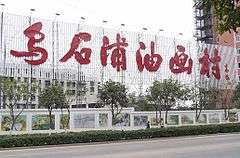
Xiamen Wushipu oil painting village has been named as “the second of the world oil painting industry base” and the second batch of national cultural (art) industry base” by the China artist association and the culture property department of Culture Ministry.
Xiamen has strong industry advantage in hand-done oil painting, which has two main manufacturing bases here, Xiamen Wushipu Oil Painting Village and Xiamen Haicang Oil Painting Village. 80% market shares in European and American market is taken up by products exported from Xiamen. As the main manufacturing base of hand painted oil painting in China, Xiamen Wushipu Oil Painting Village has more than 5,000 artists. It has the ability to produce all kinds of oil paintings with different specifications and styles. With the support of Xiamen Municipal Government, it has formed a powerful industrial chain, provided related accessories such as frames, brushes and paint colors and formed stable target customers composed by hotels, villas, high-class departments, galleries and so on. As another mail manufacturing base of oil painting, Xiamen Haicang Oil Painting Village has more than 3,000 painters. The scale of Xiamen Haicang Oil Painting Village has developed rapidly in recent years, which is from originally 28 enterprises to more than 250 enterprises at the moment. The combination of manufacturing, sales and distribution makes it become industrial base of commercial oil painting.
Media
Xiamen is served by Xiamen Media Group, which broadcasts news and entertainment such as movies and television series by AM/FM radio, close circuit television and satellite television. Media in Xiamen were temporarily blocked by the Government in June 2007 when about 10,000 people participated in protests against the building of a paraxylene factory by Tenglong Aromatic PX (Xiamen) Co. Ltd., which is owned by Taiwanese businessman Chen Yu-hao.[48] The incident, however, was solved smoothly later that year.
Colleges and universities


National
The first two universities below were founded by Tan Kah Kee.
- Xiamen University (厦门大学) (founded 1921, Project 985, Project 211)
- Jimei University (集美大学)
- Huaqiao University (华侨大学)
Public
- Xiamen academy of arts and design, Fuzhou University (福州大学厦门工艺美术学院)
- Chinese Language and Culture College of Huaqiao University (华侨大学华文学院)
- Xiamen University of Technology (厦门理工学院)
- Xiamen Medical College (厦门医学院)
- Xiamen University Tan Kah Kee College (厦门大学嘉庚学院)
- Jimei University Chengyi College (集美大学诚毅学院)
Private
- Xiamen Institute of Technology (厦门工学院)
- Xiamen Huaxia College (厦门华夏学院)
Vocational College
- Xiamen City University (厦门城市职业学院)
- Xiamen Oceanography Vocational College (厦门海洋职业技术学院)
- Xiamen Nanyang College (厦门南洋学院)
- Xiamen Performing Arts College (厦门演艺职业学院)
- Xiamen Software College (厦门软件学院)
Military
Xiamen is headquarters of the 31st Group Army of the People's Liberation Army, one of the three group armies under the Nanjing Military Region, which is responsible for the defense of the eastern China, including any military action in the Taiwan Strait.
Notable people
- Shen Kuo (1031–1095), scientist and statesman, spent some of his youth in Xiamen
- Koxinga, a Ming loyalist
- Lai Changxing, businessman
- Raymond Lam, TVB actor and singer
- Yin Chengzong, pianist
- Henry Sy, Sr., businessman, founder of SM Group and chairman of SM Prime Holdings
- Tan Kah Kee, businessman, community leader, and philanthropist in colonial Singapore, and a Communist leader in the People's Republic of China.
- Lin Qiaozhi, a Chinese physician
- Walter Houser Brattain, American inventor of the transistor; co-recipient of 1956 Nobel Prize in Physics.
- Han Kuo-Huang, ethnomusicologist
See also
Notes
- ↑ The factory represented an investment of $30,000 in bullion and $20,000 in goods.[14]
- ↑ For 1870, 314 British and 240 other foreign ships cleared the port with £1,144,046 of exports, apart from the domestic traders.[12] This had fallen to £384,494 by 1904.[5]
- ↑ For 1870, 315 British and 245 other foreign vessels entered the port with £1,915,427 of imports, apart from the domestic traders.[12] For 1904, the figure was £2,081,494.[5]
- ↑ The estimate is very rough. Pitcher, writing a little later, placed the town's population at 60–100,000.[20]
- ↑ The churches bore the names "Sin-Koe-a" and "Tek-Chhiu-Kha".[20]
References
Citations
- ↑ "Communiqué of the National Bureau of Statistics of People's Republic of China on Major Figures of the 2010 Population Census (No. 1)". National Bureau of Statistics of China. April 28, 2011. Archived from the original on 8 November 2013. Retrieved February 12, 2014.
- ↑ 2010 census
- ↑ "Amoy". Oxford English Dictionary (3rd ed.). Oxford University Press. September 2005. (Subscription or UK public library membership required.)
- ↑ Zhongguo Gujin Diming Da Cidian 中国古今地名大词典, 2855.
- 1 2 3 4 5 6 7 8 EB (1911).
- ↑ Pitcher (1893), p. 26.
- ↑ 《环球时报》2002-04-22. .china.com.cn. Retrieved on 2011-08-28.
- 1 2 中国地面国际交换站气候标准值月值数据集(1971-2000年) (in Chinese). China Meteorological Administration. June 2011. Archived from the original on 21 September 2013. Retrieved 17 March 2009.
- ↑ "Archived copy". Archived from the original on 18 March 2013. Retrieved 18 February 2013.
- ↑ Wile, Rob. "These 10 Cities Are Your Best Bet At Escaping China's Epic Pollution Problem". Retrieved 17 July 2016..
- 1 2 3 Ouchterlony (1844), p. 175
- 1 2 3 4 5 6 7 8 9 10 EB (1878).
- ↑ Struve, Lynn A. (1984), The Southern Ming 1644–1662, New Haven: Yale University Press, p. 181.
- 1 2 3 4 Pitcher (1893), p. 31.
- 1 2 3 Pitcher (1893), p. 32.
- ↑ Ouchterlony (1844), pp. 173 ff.
- ↑ Pitcher (1893), p. 33.
- ↑ Ouchterlony (1844), p. 176.
- ↑ Pitcher (1893), p. 30.
- 1 2 3 4 Pitcher (1893), p. 27.
- ↑ Cheung, David Yiqiang (2004), Christianity in Modern China: The Making of the First Native Protestant Church, Leiden, pp. 205 ff.
- 1 2 3 Pitcher (1893), p. 28.
- ↑ Pitcher (1893), p. 34.
- ↑ Pitcher (1893), p. 29.
- 1 2 Pitcher (1893), p. 25.
- ↑ An Official Guide to Eastern Asia, Vol. IV: China, Tokyo: Imperial Japanese Gov't Railways, 1915.
- 1 2 (Chinese) "侨乡厦门" 厦门市华侨博物院 Archived 12 February 2012 at the Wayback Machine. Accessed 2011-06-11
- ↑ Brown, Bill & Brown, Sue, URL=http://www.amoymagic.com/bhistory.htm,[] History of Xiamen
- ↑ (Chinese) "厦门港为赴台自由行开通夜航 拉动厦漳泉旅游资源整合" 厦门商报 2011-06-02
- ↑ Beech, Hannah (2014-07-28). "Smuggler's Blues". Retrieved 2014-07-28.
- ↑ Jing Fu (3 January 2006). "Beijing drops out of top 10 'best city' list". China Daily. Retrieved 25 April 2012.
- ↑ Daily, Xiamen (4 November 2011). "Xiamen dubbed 'Most Romantic Leisure City'". Xiamen Daily. Retrieved 22 June 2012.
- ↑ (Chinese) Compilation by LianXin website. Data from the Sixth National Population Census of the People's Republic of China Archived 25 March 2012 at the Wayback Machine.
- ↑ http://www.citypopulation.de/php/china-fujian-admin.php
- ↑ http://www.whatsonxiamen.com/news36687.html
- ↑ http://www.whatsonxiamen.com/news37938.html
- ↑ "中央机构编制委员会印发《关于副省级市若干问题的意见》的通知. 中编发[1995]5号". 豆丁网. 1995-02-19. Archived from the original on 29 May 2014. Retrieved 2014-05-28.
- 1 2 Archived 26 April 2006 at the Wayback Machine.
- ↑ Xiamen Export Processing Zone | China Industrial Space. Rightsite.asia. Retrieved on 2011-08-28.
- ↑ Xiamen Haicang Taiwanese Investment Zone. RightSite.asia. Retrieved on 2011-08-28.
- ↑ Xinglin Taiwan Merchants Development Zone. RightSite.asia (1989-05-20). Retrieved on 2011-08-28.
- ↑ Xiamen Torch Hi-Tech Industrial Development Zone. RightSite.asia. Retrieved on 2011-08-28.
- ↑ Xiamen Xiangyu Free Trade Zone. RightSite.asia. Retrieved on 2011-08-28.
- ↑ "Xiamen cracks down on electric bicycle traffic violations - What's On Xiamen". www.whatsonxiamen.com. Retrieved 2016-08-31.
- 1 2 3 4 "China Expat city Guide Xiamen". China Expat. 2008. Retrieved 8 February 2009.
- 1 2 "China Briefing Business Reports". Asia Briefing. 2009. Archived from the original on 18 February 2009. Retrieved 8 February 2009.
- ↑ Pitcher (1893), p. 38.
- ↑ Text Messages Giving Voice to Chinese Washington Post
Bibliography
- "Amoy", Encyclopædia Britannica, 9th ed., Vol. I, New York: Charles Scribner's Sons, 1878, p. 748.
- "Amoy", Encyclopædia Britannica, 11th ed., Vol. I, Cambridge: Cambridge University Press, 1911, p. 878.
- Ouchterlony, John (1844), The Chinese War, London: Saunders & Otley.
- Pitcher, Philip Wilson (1893), Fifty Years in Amoy or A History of the Amoy Mission, China, New York: Reformed Church in America, ISBN 9785871498194.
Further reading
- Ng, Chin-Keong (1983). Trade and Society, the Amoy Network on the China Coast, 1683-1735. NUS Press. ISBN 9971690691. Retrieved 24 April 2014.
External links
| Wikimedia Commons has media related to Xiamen. |
- Xiamen Government website
- What's On Xiamen
- Xiamen City Guide
- Amoy Magic - English Guide to Xiamen & Fujian
 Xiamen travel guide from Wikivoyage
Xiamen travel guide from Wikivoyage- Historic maps

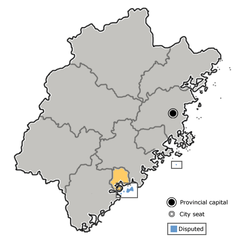

.svg.png)

